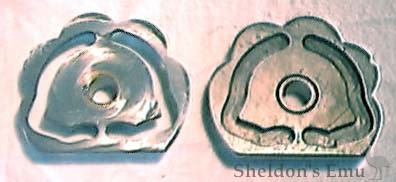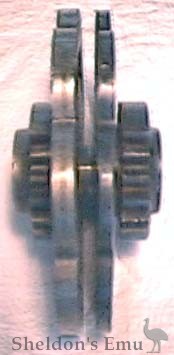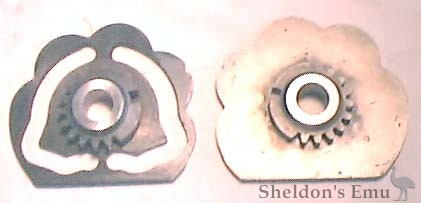



The STD plate must have the center pressed out. It is sweated in so must be heated while pressing and it will go off with a bang! After removal of the center, check plate for flatness and correct if possibly. Put a 45 deg. Chamfer on the outer end of the center. Measure the width of the plate and subtract the depth of the grooves from that figure. What's left is the width of the spacer required to go on the center before refitting the plate.
I use a roller-indexing plunger so the final width of the plate is not so important. I make and fit a spacer with an OD 10 Thou smaller than the root diameter of the center teeth. The plate is pressed on after, with the grooved side facing the center teeth. The reverse camplate is a mirror image of the STD one. They are placed in a big vice face to face with a shaft the same size as they operate on which passes through the center of them but is short enough to allow them to be pressed together.

See that all the notches on the plates line up, and then look across the plates to see that the teeth line up. If all is well press together, some heat may be required. When you are satisfied with it's final position lay it with the blank side up. Fill the chamfer with braze seeing that the plate gets red hot. You will find the inside diameter of the center will shrink and it will have to be polished out so it spins freely on its pivot.
This will soften the plate enough for it to be machined in a lathe with a carbide tool cutting from the center out. I machine it to within 15 thou then it's ground with a tool post grinder till it breaks through. Your reference point is the end of the center where the chamfer is. When finished the width of the camplate should still be the same as the original and the grooves exposed. If you reach your reference point before breaking into all the grooves try knocking them out with a punch.
If you are using a regular indexing plunger the spacer mentioned previously is replaced with a plate of correct width and a center hole of the correct diameter. The plate is ground and filed to match the out side of the camplate. Along the bottom flat edge 2 small welds can be done so the two plates do not come apart whilst the camplate face is being machined or the spacer can be drilled and plug welded to the camplate. The camplate will be somewhat softer now but will still give many thousands of miles service. Best of luck with this mod!
